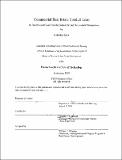Commercial real estate conduit loan : its benefits and costs from the borrowers' and the lenders' perspectives
Author(s)
Taira, Koichiro, 1964-
DownloadFull printable version (3.274Mb)
Other Contributors
Massachusetts Institute of Technology. Dept. of Urban Studies and Planning.
Advisor
Timothy J. Riddiough.
Terms of use
Metadata
Show full item recordAbstract
The conduit loan is one of the greatest financial success stories of real estate finance in the 1990s. This paper examines the benefits and the costs of commercial real estate conduit loan, focusing on the relationship between borrowers and lenders. A conduit is a loan origination with the intent of securitization through its unbundled production by secialists, whereas traditional loan providers are essentially generalists who offer a bundle of financial services to borrowers. Although the conduit loan partially filled the gap left by the savings-and-loans by funding borrowers who had lower quality collateral until the S&L crisis of the end of the 1980's, it has since sprung up to add liquidity to the market by successful financial innovations. As a result of the quantitative analyses of the loan programs of both lenders, the conduit has provided its easy access and availability of loans, national presence and comprehensive programs, disclosure of historical performance, and larger amount, longer non-recourse programs as its benefits for borrowers. On the other hand, the conduit has compensated for its flexible and customized programs, close relationships with lenders and price stability which traditional whole lenders have offered. From the lenders' perspective, the conduit brings liquidation, information risk diversification, buy-buck option of tailored loans and efficiency from specialization in substitution for underutilization of value information, adverse selection problem, price stability, flexibility and underwriting expertise which traditional lenders have offered. In conclusion, while the conduit can sustain its growth and traditional lenders may keep their position, advance of information technology may contribute to further growth of the conduit loan due to its scale efficacy and reduction of information friction.
Description
Thesis (S.M.)--Massachusetts Institute of Technology, Dept. of Urban Studies and Planning, 2000. Includes bibliographical references (leaves 49-50).
Date issued
2000Department
Massachusetts Institute of Technology. Department of Urban Studies and PlanningPublisher
Massachusetts Institute of Technology
Keywords
Urban Studies and Planning.